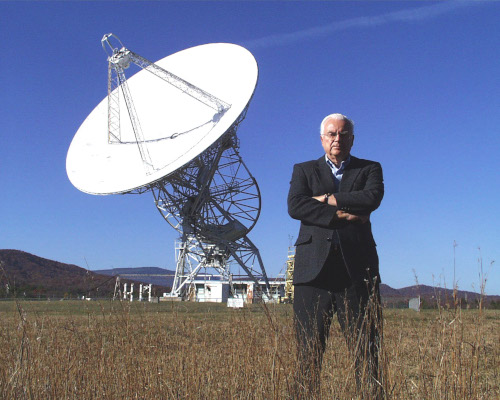 Frank Drake at the NRAO 85 Foot, 1999 (S.A. Heatherly, NRAO/AUI/NSF)
Frank Drake at the NRAO 85 Foot, 1999 (S.A. Heatherly, NRAO/AUI/NSF)
Frank D. Drake
Contributed by Kenneth I. Kellermann
Although Frank Drake is probably best known for his leadership in the search for extra-terrestrial intelligent life, (SETI), he was one of the first of a new generation of American radio astronomers who made broad contributions to radio astronomy during a career that lasted for more than half a century.
Frank D. Drake was born on 28 May 1930 in Chicago and died 2 September 2022. After receiving his BA in engineering physics from Cornell University in 1952, he spent three years in the US Navy as an electronics officer. Then, as a Harvard graduate student, Frank was involved in the early 21 cm observations at the Harvard College Observatory's Agassiz Station and received his PhD in astronomy from Harvard in 1958 based on his studies of the neutral hydrogen emission from galactic clusters. Drake then joined the new National Radio Astronomy Observatory (NRAO) in Green Bank WV as one of the first members of the NRAO scientific staff. At NRAO, he led the planning for using the 140 foot telescope then under construction, and quickly rose to be Head of Telescope Operations and Scientific Services. While at NRAO Drake used the new 85 foot Tatel radio telescope for his pioneering studies of planetary radio emission, including the measurement of the high surface temperature of Venus and the anomalous radio emission from Jupiter, which he correctly interpreted as coming from radiation belts analogous to the Earth's Van Allen belts. He also made the first high resolution study of the Galactic Center.
Soon after he arrived at NRAO, Frank initiated Project Ozma, the first SETI investigation in modern times and the first to search for radio signals from other intelligent civilizations. Although his brief search for artificial radio transmissions from the nearby stars Tau Ceti and Epsilon Eridani was not successful, it set the stage for hundreds of subsequent SETI programs, none of which have, so far, been any more successful than Project Ozma. After Project Ozma, Drake convened a small, invitation only, conference in Green Bank to discuss Extraterrestrial Intelligent Life that was sponsored by the National Academy of Sciences. It was in preparation for this 1961 meeting that Frank formulated his now famous "Drake Equation," which relates the probability of extraterrestrial intelligent life to the best astronomical knowledge. For the next half century and more, Frank Drake remained the acknowledged world leader in the quest to establish contact with other intelligent civilizations.
Drake was also one of the first astronomers to appreciate the potential rewards of pushing radio astronomy to millimeter wavelengths. With only a few paragraphs of justification, he boldly added $600,000 dollars to the 1964 NRAO budget proposal. This led to the construction of the 36 foot radio telescope on Kitt Peak which played such an important role in the discovery of the rich population of interstellar molecules. He hired Frank Low to develop millimeter bolometers for use on the 36 foot, but left NRAO for JPL before the 36 foot telescope became operations.
Following a year at JPL, Frank joined Cornell University as a Professor of Astronomy. Two years later he became director of the Arecibo Observatory and, in 1971, director of the Cornell National Astronomy and Ionospheric Center. While at Cornell he studied interplanetary scintillations, began, with students, an intensive series of studies of the newly discovered pulsars, and oversaw a major upgrade of the telescope surface to allow operation at shorter wavelengths.
In 1984 Frank moved to California to become Dean of the Division of Natural Sciences at the University of California Santa Cruz where he continued his active involvement in the SETI Program at the NASA Ames Research Center and chaired the 2nd NASA SETI Workshop intended to formulate a national strategy for SETI research. When NASA was no longer able to fund the search for extraterrestrial life, he became the President of the new non-profit SETI Institute's Board of Trustees and later the Institute's Director of the Carl Sagan Center for the Study of Life in the Universe.
Drake was a member of the AAS, the IAU, the IRE, URSI, a Member of the National Academy of Sciences, and a Fellow of the American Academy of Arts and Sciences. Early in his career, he was a member of the Pierce Committee convened by the NSF to study the needs of radio astronomy and then was a member of the first NAS decadal (Whitford) committee to establish priorities for ground based astronomy. Drake later served on many other national science policy committees and as chair of NAS Board on Physics and Astronomy, President of the Astronomical Society of the Pacific, and as a Vice President of the American Association for the Advancement of Science.
![[IAU logo]](iau_wb_thumb.jpg)
![[URSI logo]](URSI-logo-thumb.jpg)
![[Karl Jansky at his antenna]](jansky_photo_02_thumb.jpg)
![[Reber's Wheaton antenna]](Reber_Telescope_Wheaton_thumb.jpg)
![[Dover Heights]](Dover_Heights_02_thumb.jpg)
![[4C telescope]](GB61-195_4C_telescope_thumb.jpg)
![[Ewen and horn antenna]](ewen_horn1s.jpg)
![[Dwingeloo, 1956]](Dwingeloo-1956-thumb.jpg)
![[Jocelyn Bell Burnell and Cambridge antenna used in pulsar discovery]](burnell2_thumb.jpg)
![[Lovell Telescope at Jodrell Bank]](site_1594_0001-500-334-20180316163019-thumb150.jpg)
![[Wilson, Penzias, and Bell Labs horn antenna]](wilson-penzias-horn_thumb.jpg)
![[6-m Millimeter Radio Telescope in Mitaka, Japan]](6m-thumb.jpg)

